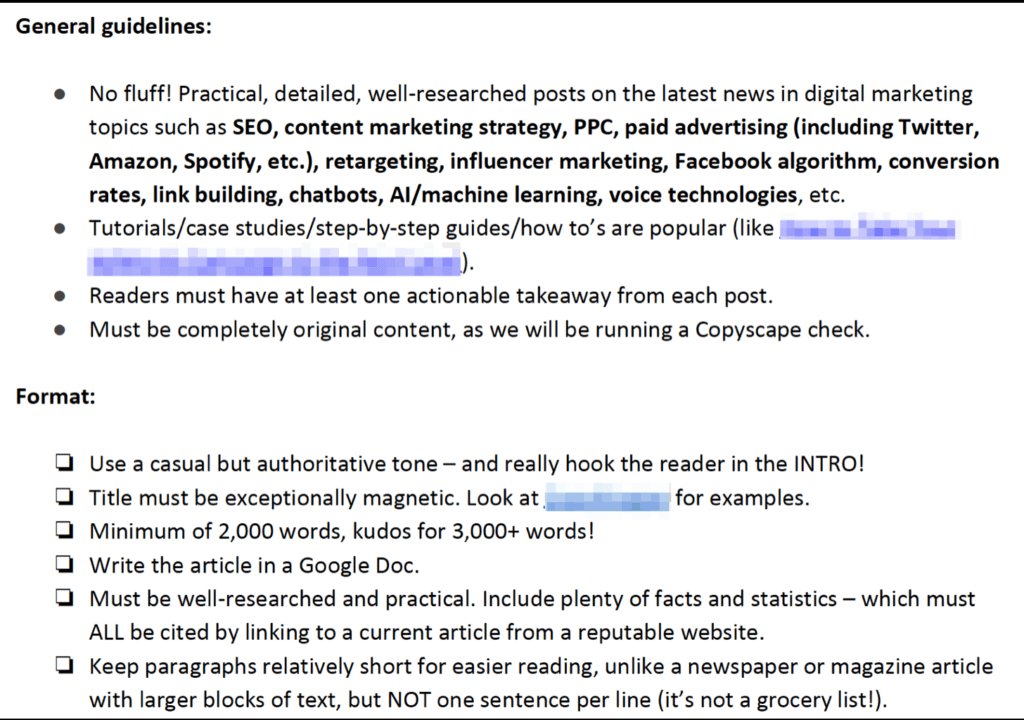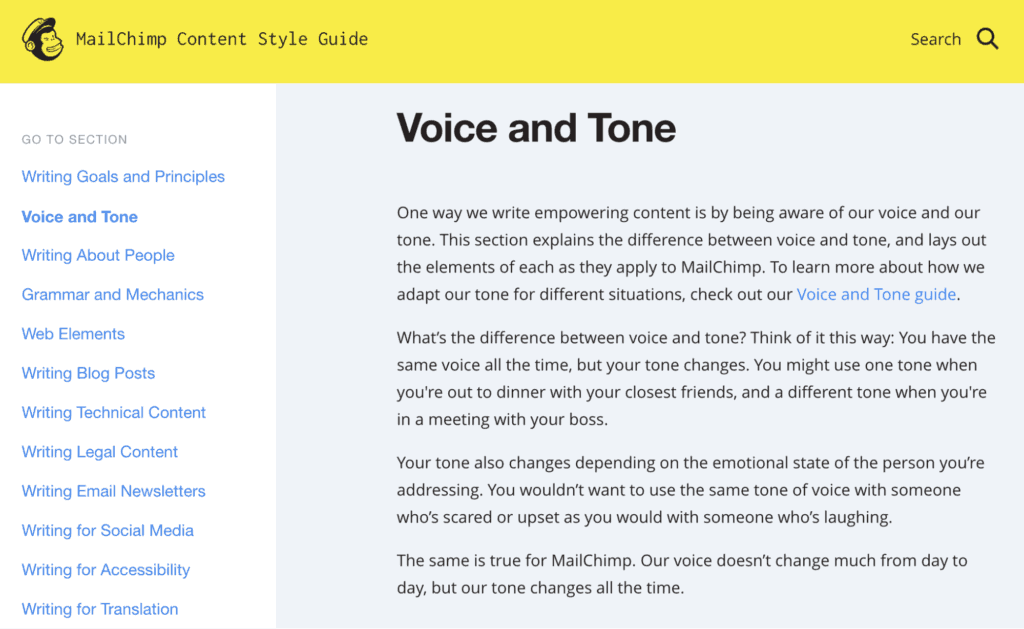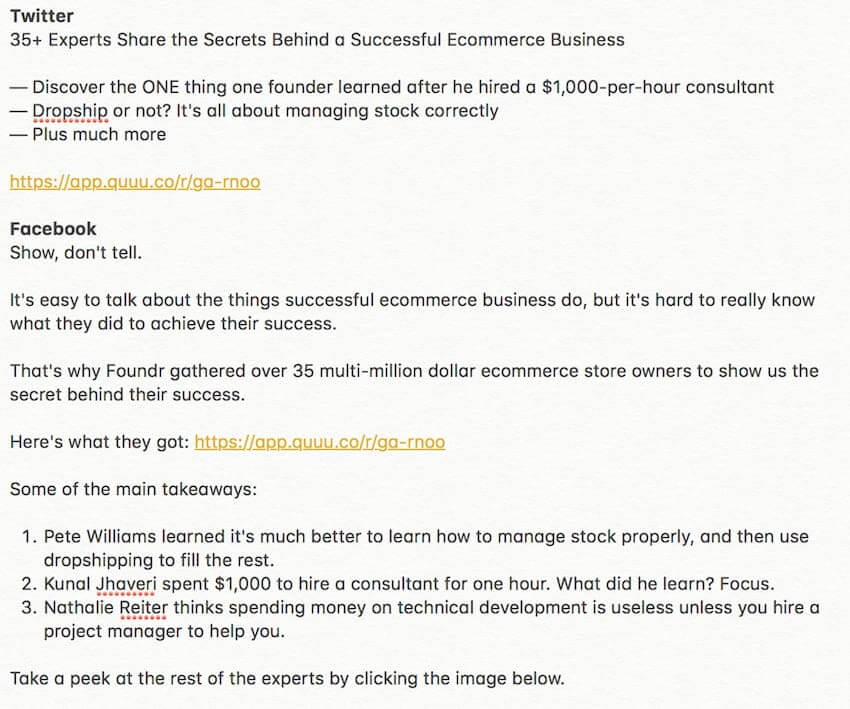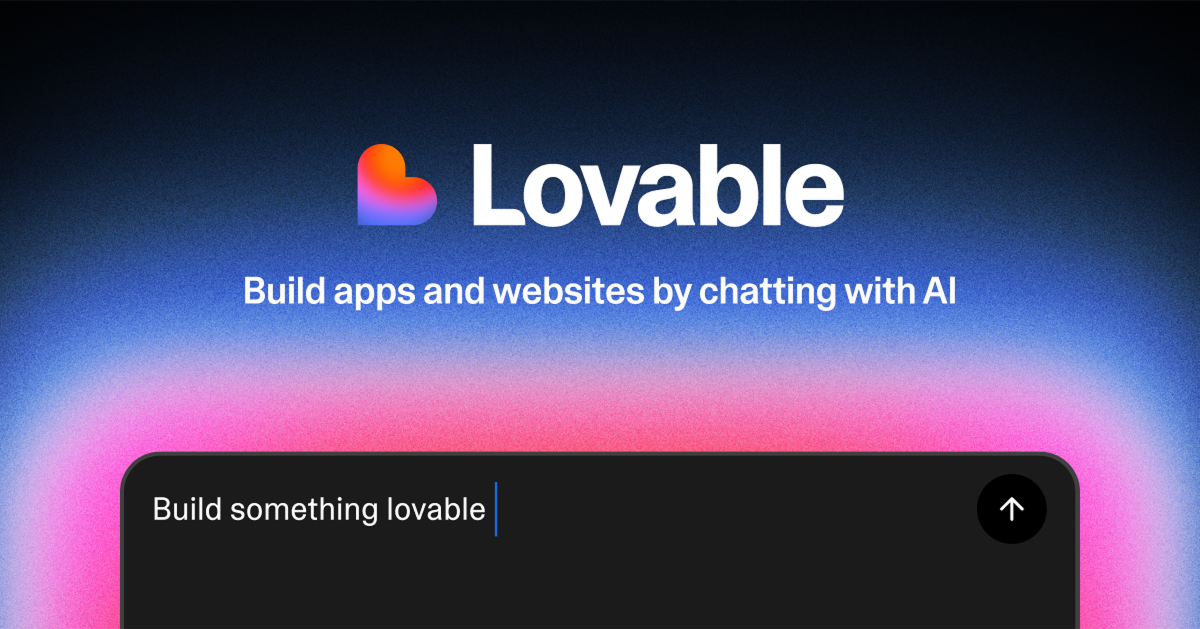Content marketing is a complex channel with multiple moving pieces.
You need to create content, promote it, measure it, and much more.
But in my +5 years of online marketing experience, I’ve seen there are a few problems most companies run into that go beyond “creating high-quality content” and other obvious pieces of advice.
In this article, I’ll share the 5 content marketing tips you need to implement this year for greater success.
Let’s get started.
Content marketing tip #1: Create a style guide
Whenever you hire a new content writer, whether in-house or freelance, you need to have him create content that suits your exact needs. How do you do it?
With a style guide.
Your style guide is the anchor on which your writers will base their content. It’s the blueprint for your site’s content.
In a style guide, you are defining:
- The tone — formal or informal
- The point of view — first or third person
- The words to use (or avoid using)
- The number of images, links, and resources to use, and where to take them from
- The formatting of certain words or phrases
- The ambiguous rules of grammar or language to follow (e.g., using full stops at the end of bullet points vs. no full stops)
Your style guide can be as simple or complex as you want it to make it. Here’s an example of a style guide a client sent me — one of the few who ever sent me one.

As you can see, their style guide isn’t that complicated.
Mailchimp, on the other hand, has a long and complex style guide their employees must use when writing their communications.

I can’t recommend having a style guide enough. It makes the life of a writer much easier, and it simplifies the editing process.
There are few things more annoying for a writer than to have a whole article rewritten because they don’t fit the style of a company’s blog. While it’s the writer’s responsibility to ask for such the style to follow, it’s also yours to be clear on the style the writer needs to follow.
Content marketing trick #1: How to develop a style guide in 30 minutes
Open a Google Docs, or any other writing software tool you like, and set a timer for 30 minutes.
During that time, you will take the following style guide structure and you will develop your own.
If you need help defining some of the elements from it, check your most popular posts to see what they had in common. You can also check what other sites have done that you have liked.
Here’s how you will structure your style guide:
Guidelines:
- Topics to mention
- Type of content (tutorials, case studies, etc.)
- Audience
- Software to use to deliver the content (Docs, HTML, Word, etc.)
- What the content must include — actionable tips, stories, pictures, links to research, etc.
Writing style:
- Voice
- Tone
- Sentence structure and length
- Paragraph structure and length
- Examples that represent your style — yours or from other sites
Editorial process:
- Explain what the writer should do to pitch you
- Should the writer recommend keywords or not?
- Define the average deadlines from the time of accepting their pitch
- Explain your editing process
If you want to make your style guide even clearer, add screenshots where you explain the different tasks the writer should follow when creating the piece of content you request.
Content marketing tip #2: Develop a brief for every new article
“To err is to be human,” they say, and that holds true for writers.
It often happens your writer doesn’t understand your original idea and develop something that’s off your intended goal.
The solution?
Create a brief explaining in detail what you want.
While it’s the writer’s responsibility to understand clearly what the client wants before he puts any ink on paper, if you don’t send them anything to work with, the writer will have a hard time coming up with something you like.
Take responsibility for the work and send them clear briefs whenever you ask for a new workpiece.
Your brief doesn’t have to be one-page long. Your brief can be a paragraph long — that’s the length most of my clients use for theirs. What matters is that your brief has at least some (if not most) of the following elements:
- The idea
- The keyword
- What the content must and must not include
- The goal
- The desired length
- The deadline
I always — always — tell my clients I don’t accept complete rewrites once they accept a pitch.
For example, if a client asks me to write an article about the do’s and don’ts of content writing for e-commerce, I won’t rewrite the whole article if I make the article about the topic.
It may seem unfair — if not rude — that I’m so strict. But it has happened earlier in my career that some clients would reject a piece because random elements of the article weren’t in place they never specified.
If you send me a brief and I miss it, it’s my responsibility to rewrite it. If you don’t and you don’t express yourself clearly, then it’s your responsibility to make a brief and explain what you want.
When requesting content from a writer, the clearer you are beforehand, the better quality the content piece will be, the more time you will save editing, and the happier everyone will be.
Content marketing trick #2: How to develop a brief in under 10 minutes
Just like you did before with the style guides, you will open your favorite notepad app and set a timer for 10 minutes.
Your brief doesn’t have to be as complicated as the style guide — particularly if you work with several writers.
You simply want to send them something as clear as possible — the clearer it is, the less time you will spend editing later on. It pays to spend this much time on your brief.
Here’s a template you will use to write your brief:
Hey [WRITER NAME],
Here’s what I need for our next post:
Our next article will be about [YOUR TOPIC]. The keyword we want to focus on is [YOUR KEYWORD].
Just like you did with our previous article, follow the style guide we have sent you before. If you want to check them again, you can access them here: [URL TO STYLE GUIDE]
For this article, we want to focus on [SOMETHING YOU WANT TO HIGHLIGHT].
The length is ~1,500 words [OR WHATEVER LENGTH YOU DESIRE]. Our deadline is [DATE].
Do you think you can make it?
Thanks,
[YOUR NAME]
In the case you’ve never worked with the writer before, make sure to mention details about your audience, your goals, and more. If possible, carry out this explanation through a call, as it’s much better for the writer to get to know you and ask you any questions he may have.
Content marketing tip #3: Define content goals
One of the first rules of management says you should always set goals for your employees. They will push them to greater lengths, keep them motivated and accountable, and it will be easier for you to measure your marketing efforts.
If you have a contractor, she may not be as motivated to work as an employee, so if you give them a goal, even a small one, it can help them create more and better content.
This goal doesn’t have to be getting their content to hit 100k monthly pageviews when your average pageview count is on the 10k for your whole site.
Rather, the idea behind setting goals is to give them something to shoot for.
Time and time again, companies have contacted me with the intention of getting help to get content created without giving me any clue as to what the ultimate goal is.
I can create a 5,000-words long article, but is that what you need? If you want traffic, are you really doing something to get that traffic?
Understanding your goals is one of the first things I do with every client. I never talk about the details of the content (e.g., length, topics, monthly schedule, etc.) — until I have defined the goals behind the content.
Is it traffic?
Is it leads?
Is it increase “thought leadership”?
Whatever it is, I always start with the goal in mind. And so you should.
Content marketing trick #3: How to define content goals TODAY
On the simplest terms, content will help you fulfill one of the following four goals:
- Increase your brand awareness
- Increase your traffic
- Increase your leads
- Increase your conversions (e.g., trial sign-ups for a SaaS business, demos for an enterprise, sales for an ecommerce, etc.)
Because the first goal is hard to measure, we’ll ignore it.
Your goal thus lies in picking one of the three goals above and build your strategy around it.
Which content goal should you choose?
There’s no clear answer. My recommendation is that you start from the top — the traffic — and work your way down as you progress.
If you already have traffic, then you can focus on creating lead-generating content, like ebooks, webinars, and other gated content pieces.
Your goal will work as what Sean Ellis calls the “north star metric,” the one thing you need to focus on when you create content.
Whenever you discuss with a writer the next topic, you know it must do one thing: attract traffic.
The same applies to the other two metrics.
When metrics aren’t enough
Metrics, however, have one weakness: they’re not easy to track on a week-to-week and month-by-month basis. How can you even extract actionable data from one?
That’s why you must develop a KPI which you will track regularly — it can be weekly, monthly, bi-monthly, or quarterly basis.
As Avinash Kaushik explains, a KPI is a “metric that helps you understand how you are doing against your objectives.”
For example, if your goal is to attract traffic, your KPI could be the number of page views. Or organic visitors. Or social media visitors.
As a rule of thumb, if you can find it as a metric filter in Google Analytics, it’s a KPI.
Content marketing tip: If you can find it as a metric filter in Google Analytics, it’s a KPI.
The most relevant KPIs for content generation are:
- New Users (i.e., visitors)
- Sessions (i.e., visits)
That means, you either focus on generating new traffic or on attracting traffic in general, new or returning.
When you focus on lead generation, your KPIs are:
- Goal completions
- Goal conversion rate
- Goal value (assuming you know how much a lead is worth to you)
Finally, when you focus on sales or sign-ups, your KPIs are the same as the previous ones but focused on the goals mentioned above.
Before we close on this section, however, let’s go over one last element that will help you track your content performance like a pro.
Ready, aim, target
Your goals will show you the way to your success. Your metrics and KPIs will keep you focused even more. But how can you measure your results on a week-by-week and month-by-month basis?
By using targets. A target is the exact number you have pre-determined as an indicator of success or failure.
You said you wanted to acquire more visitors to your site? Sure, but how many is enough?
If you attract 1,000 monthly visitors to your site, your target to hit in the next quarter could be 5,000. Every article you write should help you get closer to that number.
You can even break that down and say you want to attract 1,000 visitors in one month per every article you publish, thus pushing your promotion tactics much closer to the end result.
The exact target will depend on your current results and your resources. If you have a team with a mid-five-figure budget, and you attract 10k visitors, getting to the 50k in 6 months is doable. If you lack those resources, then you should adjust accordingly.
The key to increasing your content performance is you track everything, from metrics to KPIs to targets.
Content marketing tip #4: Know who you are targeting with your content
Understanding the audience is probably the first thing every marketer needs to do in any marketing-related activity. Whether that’s SEO, YouTube marketing, Facebook ads, or even content writing — knowing who you are targeting your campaign is paramount to content marketing success.
Imagine you commission a piece of content to a writer. That writer has his own personal voice — which, in contrast with the style and tone, never changes. If his voice doesn’t fit or adapt to your style, you will not like his work.
The same applies if you send him your style guide but don’t explain the kind of people for whom he’ll be writing. I can imagine the kind of tone to use for Fortune 500 financial managers, but if you tell me you want a formal tone, how’d I know how to specifically adapt it?
Being clear on the target audience makes it easier for me to visualize this audience reading my content. It also helps me see what people in that audience like reading, how they communicate (by doing comment mining in online communities), and much more.
The consequences of giving the writer a clear idea of the target audience are too large to ignore. If you have a persona document or any other marketing-related document where you have set the target audience of your brand communications, then share it with your writers.
Content marketing trick #4: How to define a target audience
A lot is often said about developing customer ideal buyers, buyer personas, and target audiences, all of which involve doing a mix of surveys, 1-on-1 interviews, and quantitative analysis.
I won’t dwell on the details of any of such activities for the simple reasons I’ve never done them myself. It’s not that they don’t matter — they do, and a great deal. The reason for my lack of experience is that I develop a target audience, but in a fraction of the time of most B2B marketers.
Does that replace their complex buyer persona development? Not at all. But it’s a good-enough task that has allowed me and my clients get a sharp idea of who they’re publishing for.
Your job is simple: you need to define one particular type of person you want to write about.
You could base this decision on several attributes:
- Your knowledge: If you know a lot about one specific topic and you can teach it to someone who needs that, that’d be a good target audience. Writing long-form content would be an example of mine.
- Your professional experience: If you’ve worked with certain types of people for a long time, you already know how they talk, what they do, and what challenges they face. In my case, it’d be marketing managers for marketing software companies.
- Your passion: If you are passionate about a topic and you want to share your love for it to other people, this could be a good target audience.
Amy Hoy from Stacking Bricks likes to say there are three types of audiences you can target:
- Peers
- Newbies
- Clients
If you sell B2B software, then you should focus on sharing your knowledge and your experience to your clients so you can develop, what some people call, “thought leadership.“
I hate that term, so let’s say you want to become the “boss” of your market, the OG everyone looks up to.
If enough clients (or, actually, people who could potentially be clients) read your content, some will sign up for your software. How do you do that?
Once you gain their trust. And how do you do that?
By creating and promoting content that helps them.
Long story short, define the kind of people you think you can help the most.
From there, you can build a more complex persona, adding:
- The software they use
- The celebrities they admire
- The books they read
- The blogs they read
- The podcasts they listen
- The conferences they attend
- The networking groups to which they belong
With this, you can define:
- The tools to talk about
- The sites on which you want to write a guest post
- The books to which you want to refer
- The podcasts on which to appear
- The conferences on which to speak, participate, or even sponsor
Do you see where this is going?
It’s not hard if you want to keep it simple.
Content marketing tip #5: Promote your content strategically
Build it and they will come is as bullshit as saying Milli Vanilli are the best rappers from the 90’s.
Come on, let’s be real, you can’t publish content and hope you’ll get more visitors.
If you want to use your content to leverage maximum traffic, you need to promote it — consistently.
There are two roads you can take:
- Promote your content with organic channels
- Promote your content with paid channels
The one you choose will depend on a mix of budget and availability.
While the former is the best long-term (you’ll see later why), it takes a long time. But it’s free. ¯_(ツ)_/¯
The latter is more expensive, but it’s relatively easier to run and you can track your results with precision.
The key to promote an article is for them to pass what I call the “boss test:” when your boss looks at your content piece, she has to be able to say “I f#$king love this!“
If it doesn’t pass the boss test, then any promotion you do will reap few benefits.
Assuming your content passes the boss test, then here’s how you can get started with your content promotion plan.
Content marketing trick #5: How to develop a simple content promotion strategy
A content promotion strategy, in this context, defines five aspects of your work:
- What you will promote
- Where you will promote it
- How you will promote it
- Who will be responsible
- What KPI you will use to track your results
Sounds complicated? It’s not.
Open a Google Docs document and call it “Content Promotion Strategy” or something on that end.
From there, you need to fill in the blanks for each of the five points in the above list.
The first point is easy to answer: if you are going to create a content promotion strategy that you’ll use on all of your pieces, then it’s not necessary to explain what you’ll promote.
If, on the other hand, you will develop a strategy to promote specific pieces (e.g., a long guide like the guest blogging one I created), mention that so it’s clearer for everyone involved.
The second point — the place to promote the piece — is where the sh#t hits the fan. It’s where all marketer start screaming at each other (often with their mouths full of food).
“Facebook groups are useless, nobody pays attention to my posts.“
“Reddit is full of trolls, I’m never going to publish there again!“
“Guys, Facebook Ads is where it’s at. You gotta try it!“
Let’s be real: all of these promotion channels are equally valid. The point is, as Mark Manson puts it, what you’re willing to sacrifice.
If you are willing to take the time to engage with a Facebook group before stuffing it with your content, that channel can work wonders. Otherwise, you risk getting your ass kicked by the moderators, plus gaining no respect from the audience to which you’re promoting your content.
Here’s a list of channels you can consider using in your content promotion strategy:
- Facebook groups
- Facebook page (your own, that is)
- Twitter account
- LinkedIn feed
- LinkedIn posts
- Niche forums (if they exist)
- Niche submission sites (think HackerNews)
- Facebook Ads
- Display networks
- Email list
- Other blogs
- Podcasts
- YouTube
To this list, you can add retargeting and email outreach, among other other tactics, which aren’t channels on their own, but ways on which you use a channel.
I won’t dwell on the best channel to pick because that depends a lot on your budget, time, and experience.
- If you’re experienced using PPC and have the budget, then go for it
- If you have an influential person in your company, use podcasts and guest posts
- If you know how to leverage social groups, use them
Pick the path of least resistance: whatever is easiest for you is the best channel for promotion.
The third point — the promotion itself — is relatively simple because it requires you to write a summary of your content piece in a way that looks well-suited for the community on which you promote it.
For example, this is the copy I used to promote a piece for Foundr:

It didn’t take me more than 15 minutes to write those pieces of content. Then, the rest was to add the content to Quuu Promote (a service which I don’t recommend) and other social media tools.
The fourth point — the responsible for the promotion — ideally should be the same person who writes the content. Why? Because he’s the best one to talk about he just wrote.
Most of the work around promoting content is writing copy based on the content created. Why would you give that work to someone else if the writer already knows what he wrote?
This doesn’t mean, however, the writer should work alone. On the contrary, some of the work entails finding groups on which to engage, making sure to follow up with comments, developing graphics, and so on. In those cases, the help of an assistant would come in handy.
Finally, the KPIs depend a lot on what you prefer to focus on. Some ideas you can use are:
- Impressions
- Traffic
- Comments
- Shares
- Upvotes (for a community site)
At the end of this exercise, your content promotion should outline the main points that will guide your execution. It won’t be perfect, but as you try new tactics you’ll learn what works best for you.
Here’s what you need to do now
There’s a lot of information in this article.
That’s why I want you to pick ONE content marketing tip from this article. Not two or three — just one.
Now, take the action steps below that tip you chose and tell me what’s going to be the next step you’ll take TODAY.
I want you to get started while the iron is hot. Even if it only means adding that action step to your to-do list.
Share your action step below.

